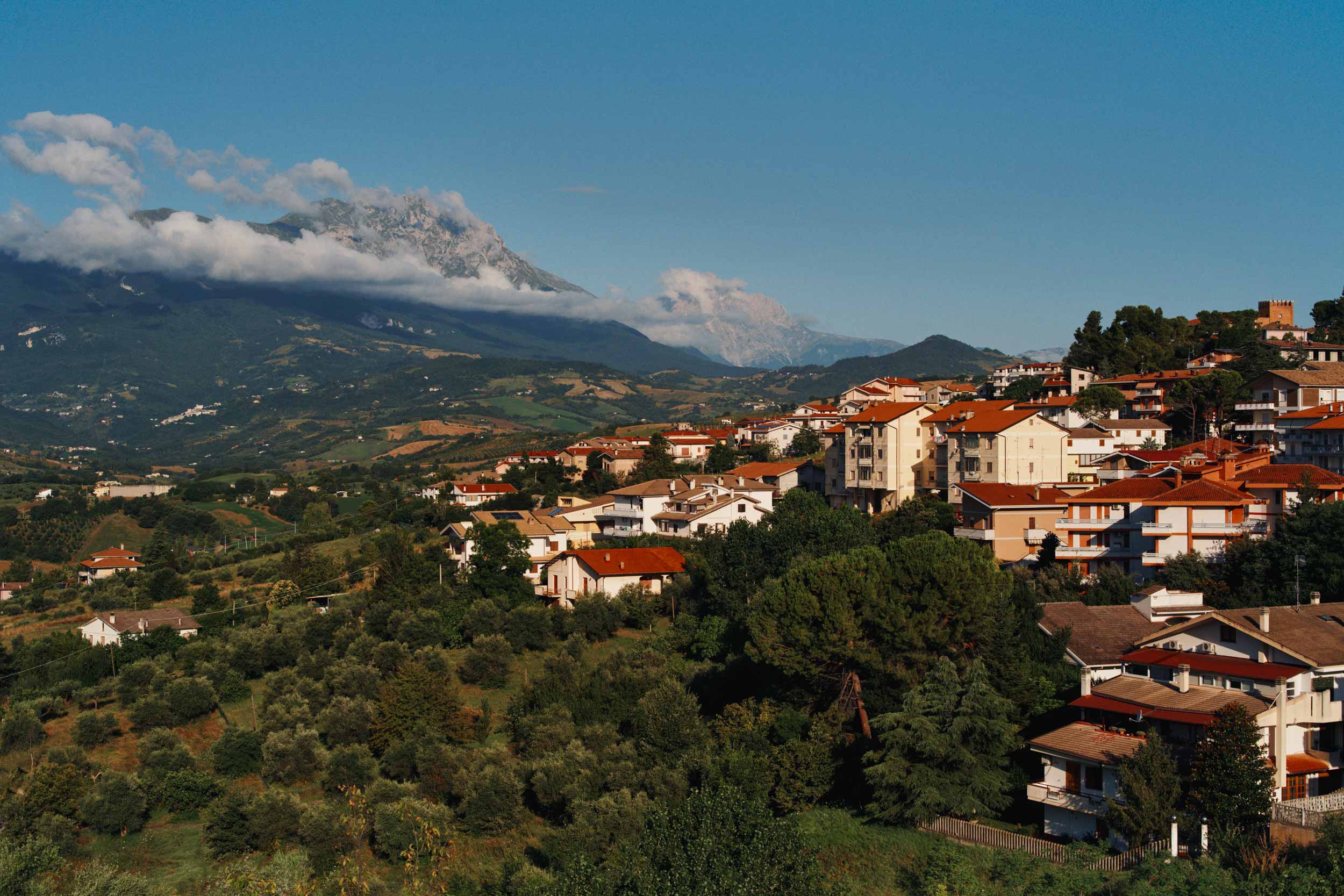For its Fall/Winter 2023 issue, Document travels to Italy’s Abruzzo region where the atelier’s heritage collides with la dolce vita
In the Italian province of Pescara, at the entrance of Gran Sasso e Monti della Laga National Park, sits the unassuming village of Penne. One of the oldest towns in the Abruzzo region, it was here that the ancient Vestini tribe established residence. They named the city Pinna, meaning pinnacle, alluding to its elevation of over 400 meters above sea level.
Around 89 BC, Penne began developing into a Roman city, becoming one of the wealthiest dioceses of the 8th century as the home of an opulent ruling-class aristocracy. In the 16th century, Margaret of Austria—who subsequently held the titles of Duchess of Florence and Governor of Abruzzo—inherited Penne and maintained that legacy. Under her jurisdiction, the village hosted Europe’s wealthiest and most influential families.
Today, a population of about 12,000 live within its interlocking web of eras, splayed across narrow, winding, and sleepy streets. In the center of town is a brick column of the Church of Santissima Annunziata dating back to 1733 and a sculpture of Christ from the 17th century. An earthquake in nearby L’Aquila left Penne with a number of uninhabitable buildings, but the column and sculpture emerged relatively unscathed. They now stand among the few accessible landmarks in the town center. Santissima Annunziata just so happens to be the patron saint of tailoring.
Directly opposite the church, in an iced pink building with white wedding cake moldings and classical balustrading, is the Scuola di Alta Sartoria, a tailoring school instituted by local made-to-measure clothing brand Brioni. Since its inception in 1985, the school has carried Abruzzo’s legacy as Italy’s foremost region for the craft.
Founded in Rome in 1945, Brioni introduced the trunk show and staged the first menswear show in modern fashion history. Held inside the Sala Bianca at Palazzo Pitti in Florence in 1952, it was here that the “Peacock Revolution” of the ’60s first appeared—where men’s style began to contrast traditional conceptions of masculinity. Many wore their hair long, and donned clothing in vivid colors and sexualized silhouettes. For its part, Brioni offered the cocktail jacket and silk tuxedos in flamboyant prints. With the help of Clark Gable, Cary Grant, and John Wayne—who were regularly fitted in the Via Barberini Brioni atelier in Rome—Brioni and its suits marked the official beginning of la dolce vita.
“From the beginning—the 1900s—if you wanted suits, jackets, trousers, or knitwear, you didn’t go to the store, you called the tailor,” explains Brioni’s Chief Master Tailor, Angelo Petrucci, a born and bred Pennese who attended the school at the age of 14 when it first opened. “The [tailor] would go to each household of 17 to 18 people, staying several months to create a wardrobe for the whole family. And instead of money, the [payment] was food.” Fifty kilos of flour for a jacket, or a pair of pants for some eggs, for instance, as Luciano Morelli, the director of the Brioni school, once told the New York Times.
Petrucci continues, “You can find Italian tailors around the world and many are from Abruzzo. The method of [Scuola di Alta Sartoria] is the same as [it was] 200 years ago. And after you finish, you do another year studying the Brioni method, which maintains the etiquette and DNA of traditional Italian tailoring of the past with new techniques and tools.”
Petrucci is warm, welcoming, and garrulous in a Brioni suit made from silk, baby cashmere, and cotton. Today, in muted gold, one imagines his closet must be kaleidoscopic. The tailor is relentless in his commitment to the brand; he admits to maintaining his slender silhouette so as to fit into his personal collection of Brioni suits. He extols the virtues of using gloves and washing one’s hands with good soap so as not to lose the sensitivity of touch when working with fabric. Offering up a cashmere sweater in exaltation, Petrucci sighs in ecstasy describing its featherlight touch. He walks through the Penne ateliers with an indefatigable Roberto Benigni-esque passion that has yet to wane in his 38 years at the company. On the record, he’ll never reveal the immediately recognizable names of whom he has carefully fitted (though results of a quick Google search mention Obama, Mandela, Pharrell, and Pacino), but he might disclose their specifications, such as a 21-carat gold thread woven through a pinstripe upon request for a certain Malaysian sultan, or the extra millimeters required to offset a particularly short-legged 007 (Brioni outfitted the eponymous character for several films before Tom Ford stepped in for Quantum of Solace in 2006).
Indeed, Brioni is best known for dressing Bond in black tie and creating handcrafted bespoke suits. The Italian brand has dressed presidents, Oscar winners, Olympic sportsmen, kings, and princes.
“In the ’50s, a tailor [would only propose] men’s evening wear in navy, cream, or very dark green tuxedos, and [Brioni] came along with pink jacquard. It was absolutely avant-garde,” explains the mild-mannered Executive Design Director of Brioni, Norbert Stumpfl. “When you think about the [2020] Balenciaga show that Demna did where the [catwalk] was flooded with water, Brioni did this in 1964 in New York at the Waldorf Astoria and flooded the lobby. They had a show on a plane [at altitude]. There’s a lot of history.”
Stumpfl began tailoring at the age of 13 and studied at Central Saint Martins where his preternatural technique led to evening work under Alexander McQueen, followed by menswear tenures at Lanvin under Lucas Ossendrijver, Balenciaga under Demna Gvasalia, Louis Vuitton under Kim Jones, and Berluti, before he joined Brioni in 2018.
Stumpfl shuffles between Rome, where he and the brand’s headquarters are based, and Penne every month or so. “I love the place, it’s the heart of Brioni,” he says of the latter. “We mostly go there for fittings, give new ideas for the new season, and try to find new techniques and ideas to talk through as to how we can make Brioni more modern but still keep traditional handcraft.”
“Penne was always a place where manufacturing happens. Bags are made in Florence, shoes are made in Naples, fabrics are made in Como—you have areas [in Italy] that are known for certain things,” Stumpfl explains. “In Abruzzo, they’re known for handmade tailoring. Our founders, [Nazareno Fonticoli and Gaetano Savini] were Roman, based in Via Barberini, and they had so many orders that they couldn’t [keep up], so they opened this place in Abruzzo because they knew there were a lot of people specialized in tailoring [there].”
Despite the lofty clientele, it’s business as usual for the tailors back in Penne, as it has been for centuries. In the ateliers, workers bring in homemade ricotta, olive oil, and panini to eat in the cafeteria alongside creative directors and product managers. A priest comes to celebrate each Christmas and Easter.
“I was born in Penne and I live in Penne. I’m sure [I will stay here] until I leave my best life, when I pass away,” beams Petrucci. “I’ve traveled everywhere—New York, Malaysia, New Zealand, Australia. This place is paradise.”









































